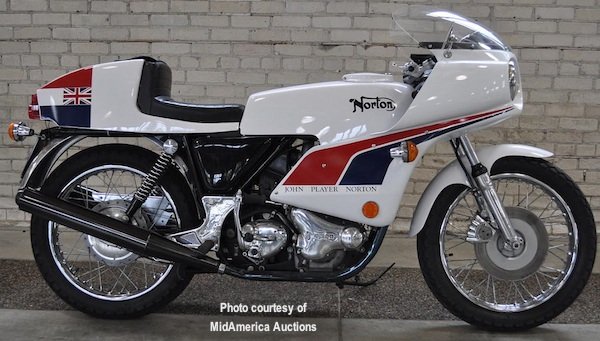1973 Norton Commando
ABOVE: 1973 Norton Commando 750 Roadster was more or less the “standard” Commando.
BACK ON TRACK
After the dismal finish of the 1972 model year, thanks to the Combat engine, 1973 was a good year for Norton Motorcycles. The entire model line had benefited from the engine fixes developed to counter the Combat’s tendency to break pistons & eat main bearings. The new Superblend main bearings were now standard on all models. While the Combat engine continued to appear in the catalog briefly, it had been canceled in 1972 because the problems were just too great & Norton’s scarce resources needed to be directed into its mainstream line of engines.
MODEL DESIGNATIONS
When the 1973 Norton Commando lineup was announced, the Commando Fastback & Fastback LR had been dropped. The 1973 Norton Commando Roadster, Interstate & Hi-Rider continued on in MkV form, now with optional turn signals, which had only been listed for the first time as an option on the 1972 Norton Commando Interstate. All engines now had the 32mm Amal 932 Concentric carbs & intake tracts from the Combat engine, but with reduced compression ratio & higher gearing. Only the Hi-Rider soldiered on with the old 8-inch TLS front brake, all others now had a single front disk brake on the right & the old drum out back.

ABOVE: The 1973 Norton Commando Interstate was the long-range touring edition.

NEW 850 COMMANDO
The biggest news for the 1973 Norton Commando was the new 850 Commando line. Yes, the ancient 1948 Bert Hopwood design that started life as at 500cc, had one final growth spurt, this time to 829cc, to be called the 850 Commando. This was accomplished by boring the cylinders out to 77mm & retaining the 89mm stroke. The compression ratio was lowered to 8.5:1. Power output was advertised as 60hp at a leisurely 6,200rpm, but was probably more like 53hp, pretty much the same as the 750. The difference was that the 850 got it done with much less stress, at a lower rpm & was thus smoother & more reliable. Prolonged cruising at 5800rpm was possible & this calculated out to about 100mph in top gear. A redesigned cylinder block now had through bolts from head to crankcase as well as short studs & nuts. Flywheel weight was adjusted to compensate for the heavier pistons. An all metal clutch & reinforced gearbox casing were added. A cross-over pipe now joined the two exhaust pipes just downstream from the heads.
750 & 850 ONE YEAR ONLY
The 750 & 850 were both produced throughout most of 1973 & were available in all models. In October 1973, the last 750 rolled off the assembly line. Well, that’s not exactly correct. Because a new short-stroke 750 was briefly offered as an option on the John Player Norton & the Commando Roadster. By shortening the stroke to 80.4mm while retaining the 77mm bore from the 850, the new displacement was 749cc (the old 750 was actually 745cc), with a less undersquare engine geometry. This engine was an offshoot from the works experience Norton gained in production racing.

JOHN PLAYER NORTON
The hot new John Player Norton took the Norton Commando Production Racer & did it one better. Its stunning red, white & blue paint scheme & unique classic cafe-style fairing, tank, seat & tail section made this one of the most eye-catching motorcycles of all time. It came standard with low clip-on handlebars & rearset footpegs & foot controls. The fairing had 2 side-by-side headlights flared in, along with standard turn signals.
TROUBLE IN PARADISE
By 1973, Norton Motorcycles looked like the strongest, most viable of the British Motorcycle Manufacturers. Once might BSA & Triumph had sustained huge losses & suffered from horrendous management & were on the verge of collapse. In July 1973, Norton’s parent-company, Manganese Bronze Holdings, with help from Britain’s Department of Trade & Industry, bought the beleaguered BSA & Triumph and formed a new company called “Norton Villiers Triumph”, or NVT. With it came a new plan: Close Triumph’s legendary Meriden factory & move all Triumph production into Norton’s Wolverhampton plant. When the Triumph workers got wind of this, they immediately took over the Meriden facility & held it for 18 months, halting all Triumph twin production throughout most of 1974 & all of 1975. This on top of all the other problems Norton was facing at the time was simply more than they could handle.
1973 Norton Commando SPECIFICATIOS
|
Model designations:
Engine type Displacement 750 Displacement 850 ” Short-Stroke 750 Bore & Stroke 750 Bore & Stroke 850 B & S Short-Stroke 750 Compression Carburetors Ignition Engine output Oil system Oil capacity Primary drive Clutch Gearbox Ratios, overall: 1st, bottom 2nd 3rd 4th, top Final drive Frame type Suspension, front Suspension, rear Brake, front Brake, rear Wheelbase Seat height Weight |
Fastback Interstate Roadster Production Racer Hi-Rider
Air-cooled OHV parallel twin 746cc / 45 ci 828cc 749cc 73mm X 89mm / 2.875″ X 3.503″ 77mm X 89mm / 3.03″ X 3.503″ 77mm X 80.4mm / 3.03″ X 3.17″ 8.5:1 2- Amal Concentric, 32mm Battery & coil, Lucas 60 bhp @ 6200 rpm Dry sump 6 pts Triplex chain Multi-plate diaphragm, wet 4-speed constant-mesh, right-foot shift
12.40:1 8.25:1 5.90:1 4.84:1 Chain Welded double cradle, Isolastic Suspension Telescopic fork, hydraulic damping Swing Arm, 2 dampers, Isolastic mounts 10″ disk, 2-piston hydraulic caliper 7″ SLS drum, full width 57.1″ 31.3″ 430 lbs |


